Ah, guidebooks. The world’s most derided travel accessory. Filled with hundreds of pages of practical information, yet spurned with the contempt befitting a bitter arch-nemesis.
“You don’t need a guidebook. The info’s always wrong, and you can just ask people for help instead.”
Okay, fair enough. But I’ve always wondered what these people do when they get into town at 4am and there’s no one anywhere in sight, without a map of the town to lead anywhere useful. What’s wrong with guidebooks then?

Much of the debate around guidebooks focuses on inaccurate information, and subjective opinions; in other words, prices tend to be wrong, and hotel and restaurant recommendations aren’t particularly inspiring. And yes, it’s sometimes true.
But personally, I’ve never bothered using guidebooks this way. I only ever use them for info that rarely changes: Maps, and history. Knowing where I’m going and what I’m looking at is incredibly convenient, and far more fulfilling. If I don’t have a map, I feel like I’m wasting time. If I don’t have a history lesson, I feel like I’m missing out.
Plus you’ll get things like bus schedules, basic phrases, cuisine info, etiquette tips, what number to call instead of 911…the list just goes on and on.
And sure, you could find this info online for free, but if you want to take it with you, you’d either need to print out dozens or hundreds of pages, or look it up on your phone, and deal with roaming charges or SIM card purchases, and battery drain. If you plan on picking up free maps from tourist offices, you have to find the place that’ll give you a map, before you have the map…for every town.
I can generally see where the non-guidebook backpackers are coming from, but it has always seemed to me like $30 for a guidebook with just about everything you need is a pretty good deal, and if you ignore all the subjective restaurant tips anyway, there’s not much to complain about. Besides, it also makes for great reading material on those 36 hour bus rides, particularly if you’re learning about your next destination while en route.
I expect that someday we’ll all have amazing smartphones with infinite free international internet connections and battery life, but until then, paper works just fine. I’m happy to have maps and history lessons on hand at all times.
But there’s one overwhelmingly annoying nuisance that guidebooks have resoundingly failed to resolve:
Bulk.

Guidebooks are unnecessarily obese tomes of questionable value if you’re only ever using a few pages per day. And I think this is why so many people go out of their way to find methods that’ll allow them to ditch the guidebook. It’s just such a hassle to haul around, so they just don’t bother.
But neither do I. I only ever take a few pages at a time, and it’s just great.
How to fix the gigantic brick guidebook problem
Instead of carrying around a massive volume, I slash the guidebook into teeny pamphlet-sized country chapter booklets, which conveniently fit into a back pocket, drastically reducing the nuisance of having to carry gigantic things around all day.
It ends up looking like this:
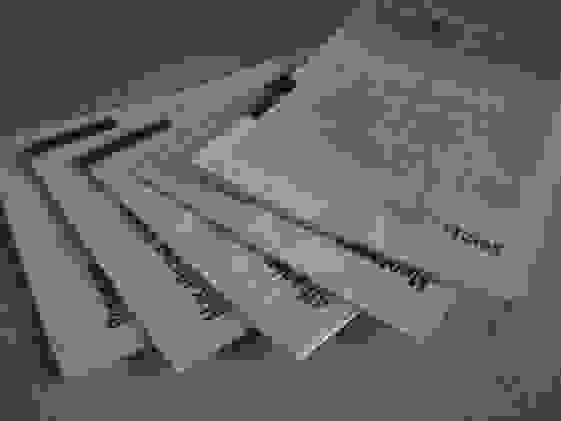
If you tape the edges, they’ll outlast your trip, and you can hand them out to fellow backpackers on your way to your next adventure. Or you can leave them in random bus stops, like a secret backpacking Santa. It’s actually pretty easy, and it makes for a fun little arts and crafts project.
To do this, you’ll need to buy the regional guidebook instead of single-country volumes, which gives each country its own chapter. Generally these offer a decent amount of information for most visitors, though I would recommend trying to get as specific as possible thereafter (get the guidebook Western Europe rather than just Europe, for example).
You could use the same technique for single-country books––China and India guidebooks tend to be huge, so it might be helpful to split them up too.
Onward we go!
Tools needed:
- Guidebook
- Sharp knife
- Packing tape
Step One: The incision
Open up the book to the beginning of a country chapter, opening it as far as it’ll go, and gently cut right into the spine. It won’t feel like it’s doing anything at first; just keep slicing, over and over again, until you can push it apart a little more each time, and eventually you’ll cut through:
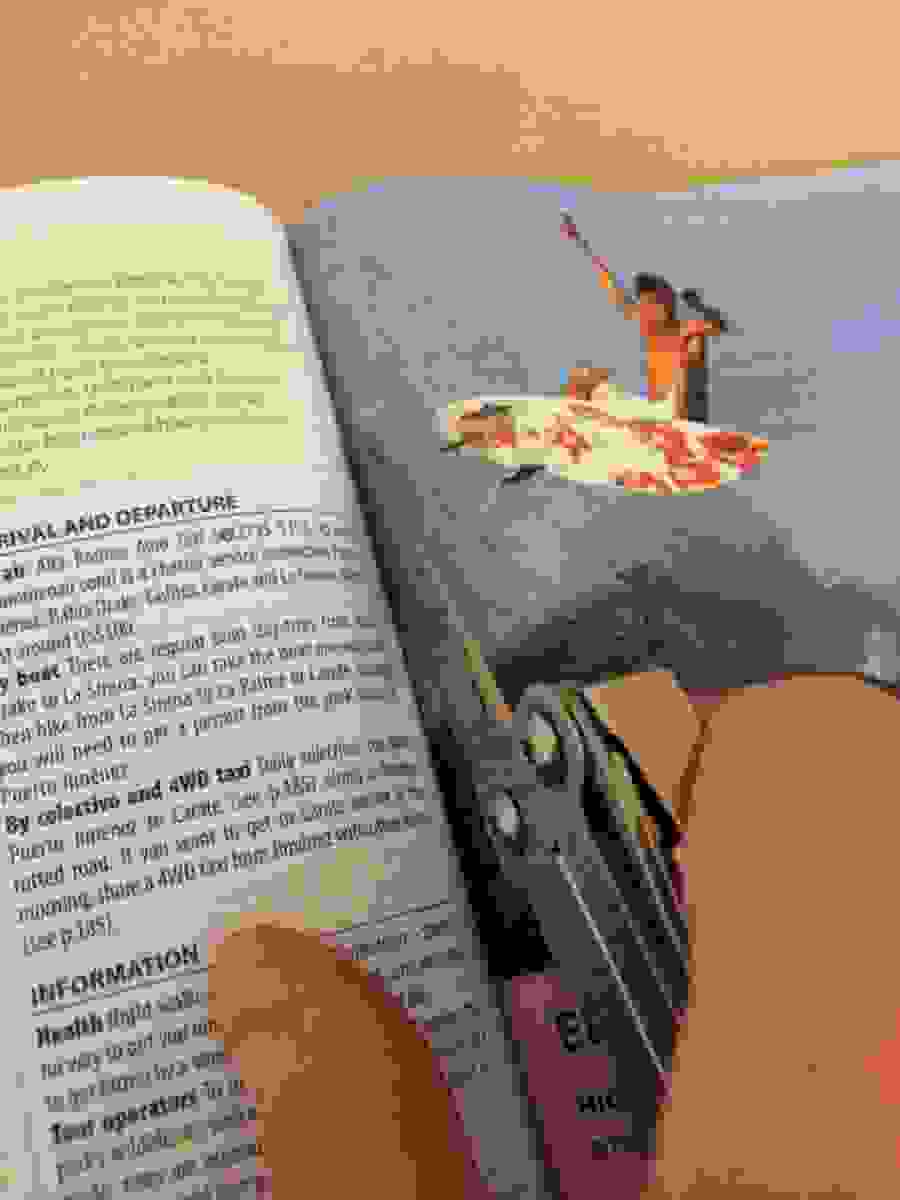
This method preserves the glue of the spine; ripping out pages will not.
Keep doing this until you’ve cut each country chapter into its own mini-booklet. Remember to do this for the book’s intro chapter as well, which gives info on the whole region, and is quite useful.
Step Two: Tape!
Tape over the entire front and back, along every edge. I like to go parallel along the vertical, like this:
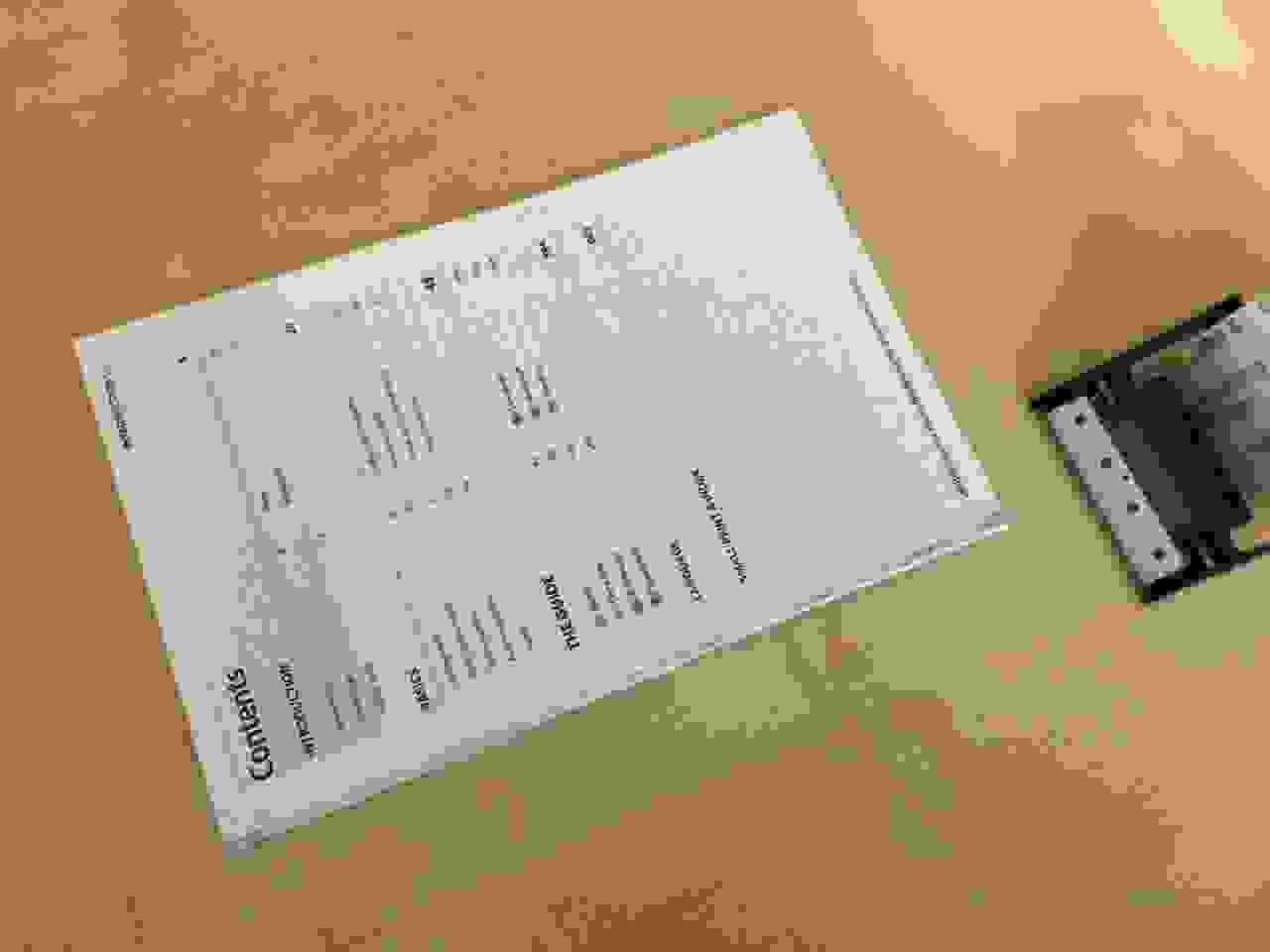
Fold over the edges whenever you can, and cut them off when you can’t.
Keep taping until you’ve taped the entire front page, and the entire back page. It’ll be super durable this way.
Step Three: Binding repair
The first and last page are the most precariously secured, sometimes detaching from the binding completely, as you can see below. So open them up, and tape right along the inner spine:
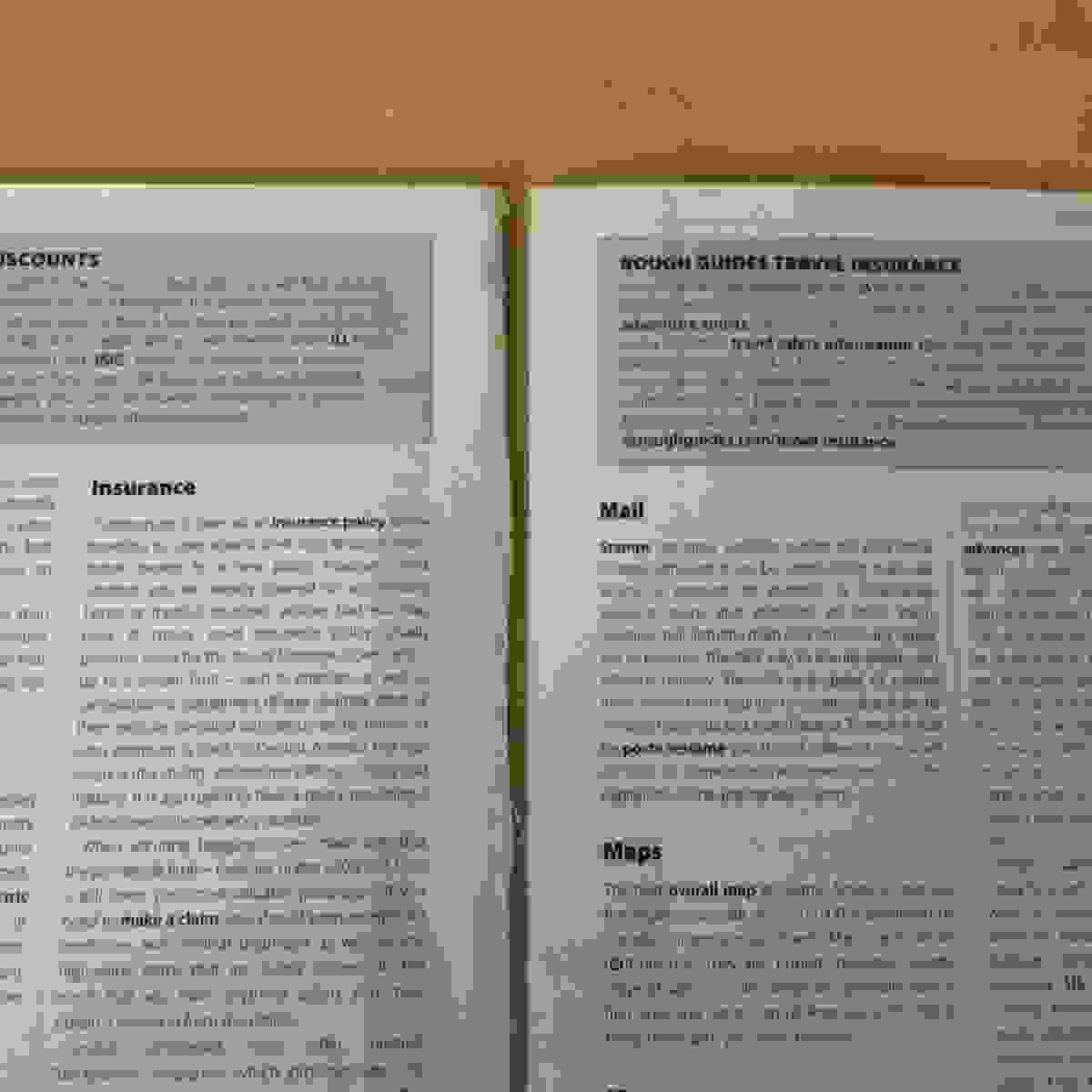
It might end up a little crooked this way, but it’ll stay together. You generally only have to do this for the first and last page of each booklet.
Once you’ve taped the entire front and back cover, and any loose pages, it’ll look like this:
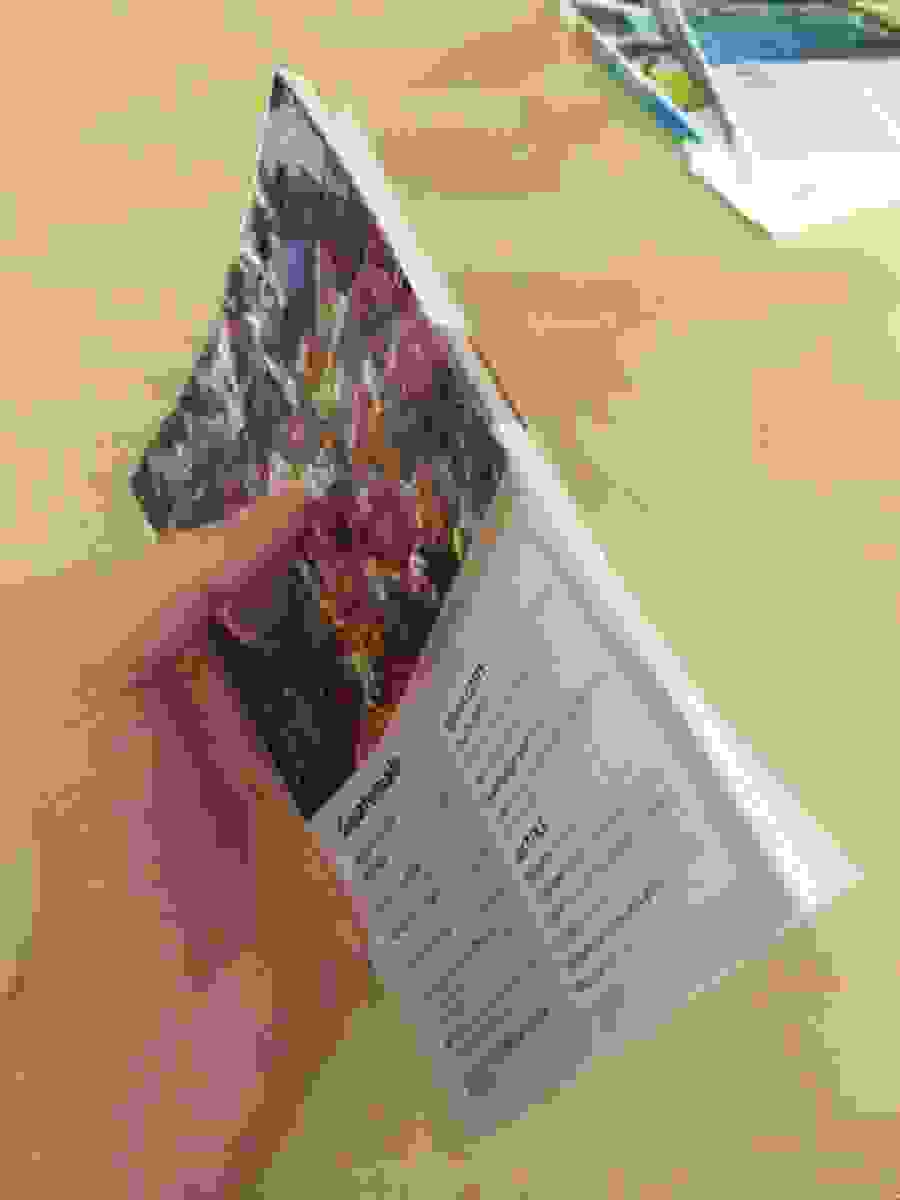
Thin, light, strong, and utterly convenient. It’s great.
I think this is a big reason why I still use guidebooks. I’d go crazy carrying the whole thing around all day, which I think is why so many people try to do without it. But if you cut it down to size, it won’t hold you back.
Maybe I’ll go all-digital someday, but in the meantime, I’m content to be a cantankerous old man who fears newfangled contraptions and refuses to change.
Besides, it’s not old-fashioned. It’s vintage!




Good tip!
Guidebooks are always a problem for me. Last year I carried the kindle version of the guide to Jordan on my iPad mini. This left me with two problems.
(1) While my companions would pull out their dogeared books and rapidly flip to the page to see the history of a site we were visiting, I would be left desperately trying to find the place in the Kindle app, which doesn’t have very good chaptering or internal links.
(2) The iPad was hard to read in the sun, and I felt self-conscious about even opening it in front of local people who obviously couldn’t afford a fancy iPad. Half the time I’d end up leaving it in my bag.
Problem #2 remains, but I did discover something interesting for those who want a digital version with fully zoomable maps and a layout that looks exactly like the paper one. The Rough Guides, which to me seem slightly better than the Lonely Planet ones anyway, offer access to the ePub, Mobi and PDF version for one price, if you go directly through their site. They are also DRM-free. I downloaded the one for Wales which ended up being the same cost as what you pay on Amazon for ONLY the Kindle version, and I found the PDF much, much easier to navigate and read.
I think it’s nice to have at least the option of a Kindle version, but the problems you bring up aren’t going away. Taking out a Kindle when you need to find something seems like it might get weird after a while…
We used Kindle versions of travel guides on a Kindle Paperwhite while in Italy. It took a day to get used to using it while out and about but it worked well. I made sure I was familiar with the material for the day and used bookmarks all the time to flip back and forth. Maps are zoom-able, it fit in my front pocket, and I was less worried about bringing out a Kindle than I am about bringing out a tablet.
In future trips, it will be a Kindle for travel guides and the app Triposo.
OMG VANDALISM!
I kid, I kid.
Well…not really.
I like guidebooks. Yes, they are bulky and heavy, but I really love my Eyewitness Guides. With glossy pictures and cute drawings of must-track itineraries, they are alike a special souvenir from each voyage,
Eyewitness Guides are great for pictures and diagrams. I haven’t used one on an actual trip yet, but they’re the best for photos and research to see which things you want to visit.
Thanks Snarky this is a great tip not many people do (since we were all tought to keep our books in good order in grade school!)
– I have been doing it for a while as well (binder-clips are good too). I learned it a while back from Rick Steves – who insists on ripping out or cutting out sections of his own books! :)
I usually have at least two region/country books since not all have the same info (Rick Steves, Rough Guide and/or Lonely Planet) – this cutting method really helps save space and weight – and easy to share or toss. And you can save those chapters you wont be traveling to at home for another journey :)
You make one more important point – the $25-30$ for the latest edition can be well worth the money for a 2000-3000$ trip! Using old or borrowed copies is ok for basic route research but having fresh current text is well worth the cash for actual travel!
I wish some of the big companies would offer smaller options like this. It would be great if they sold them as country chapters with nice binding, for maybe $5 per country or something like that. Oh well. And yes, for some reason, people always say they don’t want to pay $30 for a guidebook, but it seems weird to avoid it for a $3,000 trip, especially since they’ll spend several hours trying to find the same info online, and maybe printing it out too.
Hi Nomad,
Great post, I just wanted to add, I know you might not be a great fan of the Lonely Planet guides, but they do offer you the possibility of buying books “by chapter”, with a downloadable PDF. Prices are ok, I guess.
Let me give you an example (and I am quoting from their European site), let’s take, I don’t know, Yhailand for instance. You pay 23 euro for the paper book, 16 for the digital book or 3.5 euro for a chapter. You choose and download/print whatever you need.
Mind you, this is not available for ALL the catalogue, at least so far, but it could be a help for those of us, like me, literature graduate, who feels really bad about cutting books ;-)
Regards from Milan ;-)
You can print chapter by chapter? That would be great. I’ve been wanting something like that forever. And I feel bad cutting books apart too (all my books look like they’ve never been read, even if they have), but guidebooks just become irrelevant and inaccurate after 5 years or so, so I don’t feel so bad ruining them.
I’m currently on a three-month trip and I have left all analog books at home, for the first time in my travel life. I don’t regret it.
For maps, I carry off-line open street maps in my iPhone MotionX app, and they’re freaking brilliant.
For travel guides, I have used a few e-books from Lonely Planet, and I’ve gotten pretty good at using the search and bookmark features. I’d say I’m about as quick using these now as I would be flipping through paper pages.
There used to be some useful travel apps from Lonely Planet- these $5.99 city apps were quite good but I guess LP weren’t making any money off them, so they’ve discontinued them and have now just reproduced their paper books in e-format for a higher price. I don’t mind paying if it’s good information but man, you quickly bump up against an e-book’s limits when you’re used to interactive apps. As in, don’t tell me where the stupid coffee shop is: show me, and guide me there.
At any rate, I just can’t justify the bulk and weight of paper books any more. Not just guide books; I’m a naturalist and have switched to digital field guides too. They have huge advantages: they filter information based on locale, and have multimedia in addition to verbal info. I’m hooked.
I’m definitely going Kindle for the next trip, for the size and weight reductions, and I expect that once Wi-Fi becomes global, guidebooks will kind of disappear, as is already sort of happening.
*Thailand, I meant, sorry ;-)
I load my guidebooks into iBooks on my iPod Touch (small and discreet). Search works well to find info quickly. Sites like ebook3000 have a large number of free guidebooks if you have a tight budget and are into that. The iPod Touch also has offline maps (no Wi-Fi required) and serves as a computer and free phone (no roaming charges) where Wi-Fi is available. There are tons of useful travel apps.
awesome and simple idea, thanks !
firstly travel books annoy me, then I found them quite useful, but still is heavy and bulky, I tried the digital one… nope, never use it (I borrowed my friend’s book).
now I know ! Thanks again